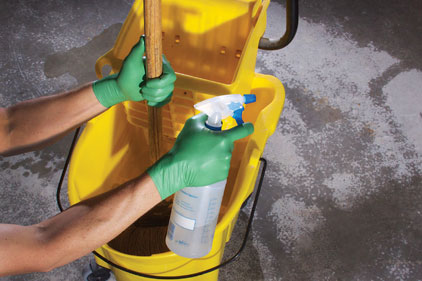For instance, what becomes of the gloves when a shift is over? Some styles are launder-able, enabling the user to reuse their gloves multiple times before the need arises to switch them out for a new pair. Other styles, such as disposable nitrile, by design do not have this luxury and are tossed into the trash after use – sometimes expending five to ten pair a day depending on the industry.
Industrial applications annually expend a massive amount of disposable waste, filling landfills with gloves and many other waste materials difficult to impossible to breakdown. In total, the U.S. solid waste industry managed approximately 545 million tons of waste in 1999. Of the total, about 374 million tons, or 68 percent, was landfilled; 31 million tons, or five percent, was incinerated; and 140 million tons, or 27 percent, was recycled.*
R&D teams in some of the most influential global hand protection companies are looking to break this trend with the advent of materials that will make an impact on our global hand print. Just a few of these discussion points include:
Using sustainable materials
This is key and gaining popularity, yet there are only a few products that can currently make this claim within the hand protection industry today.
Biodegradation is the chemical dissolution of materials by bacteria or other biological means. The key is to produce biodegradable gloves without a loss in protection and performance. When it comes to disposables, the leading trend is biodegradation. The issue is that typical materials such as nitrile cannot attract enough (if any) microbial activity to begin breaking down the polymer’s molecular structure – thus leaving the process of reclamation to light, heat, mechanical stress and moisture.
Groundbreaking products and programs do exist within this niche of the hand protection marketplace, and one such example is biodegradable disposable nitrile gloves. This product is composed of organic materials designed to make the gloves more attractive to microbial activity. As microorganisms consume the material they excrete enzymes that depolymerize the nitrile, leaving biogases and inert humus in their wake.
Organic Material: Another popular sustainable product is the use of bamboo fiber within the gloves shell. More than a decade old, turning bamboo into fiber offers sustainable value, since these gloves are made of “environmentally-friendly” materials. Unlike synthetic fibers, bamboo is not petroleum-based, which is becoming more important in a world of high oil prices and dwindling reserves.
Recycled Materials: Post consumer recyclate (PCR), for example, is derived from recycled soda and water bottles and is gaining popularity as a valuable raw material. Reusing plastic takes less energy, uses fewer natural resources, and helps reduce landfills. Demand is also increasing for fibers such as biopolymers based on starch, cellulose and polylactic acid (PLA), which are used in disposable products.
Recycled packaging
Aside from the gloves themselves, a fundamental first step in the supply chain could potentially be the materials used in the packaging of hand protection products. Using 100% post-consumer waste and dispensers from 100% recycled material is one such way to improve this trend, which reduces packaging waste tremendously.
Extended-life products
One should use gloves for as long as they are effective – which in most cases is quite a bit longer than users anticipate. Be aware of what is and what is not launder-able. Enabling this practice within a company’s PPE plan is one step to minimize the quantity of gloves that end up in landfills prematurely.
For example, many {supported} glove styles can be laundered, which means they can be washed or dry cleaned and then re-used for added value and sustainability. Mechanical and/or chemical resistant properties typically remain after three washes but this depends on the degree of wear to the glove, which must be checked.
Building a conservation culture
Being more socially and environmentally responsible often starts with long-term sustainability planning, building a conservation culture and tracking these long-term goals. There is a need to focus on pollution prevention, energy efficiency, waste reduction, and designing products and packaging to be environmentally friendly. Gradual, minor changes across the supply chain can make prolific strides to reach long-term sustainability goals. A long-term goal may for companies be to become ISO certified within all manufacturing facilities – meaning these have trackable, environmentally-friendly policies in place.
True sustainability
Sustainability is as much a corporate culture as it is an additive. It is a trend that will continue to guide the hand protection industry in the years to come. R&D teams in this industry will continue to create new, more efficient ways to decrease the hand print on our planet, and at the same time, determine the viability of recycling materials for reproduction and repurposing.
An interesting viewpoint on sustainability comes from Deborah Grubbe, chair of the AICHE (American Institute of Chemical Engineers) Institute for Sustainability and owner of Operations and Safety Solutions, LLC. “Consider safety, particularly human safety, as the ultimate form of sustainability… [if this isn’t the case] Why do we need continued innovation? Why do we need enlightened leadership? It’s so the human race can continue to survive, to flourish. And one way to do that is to assure the human race is as safe and sustainable as possible.”
In this sense, we are all stewards of sustainability. I guarantee it.

